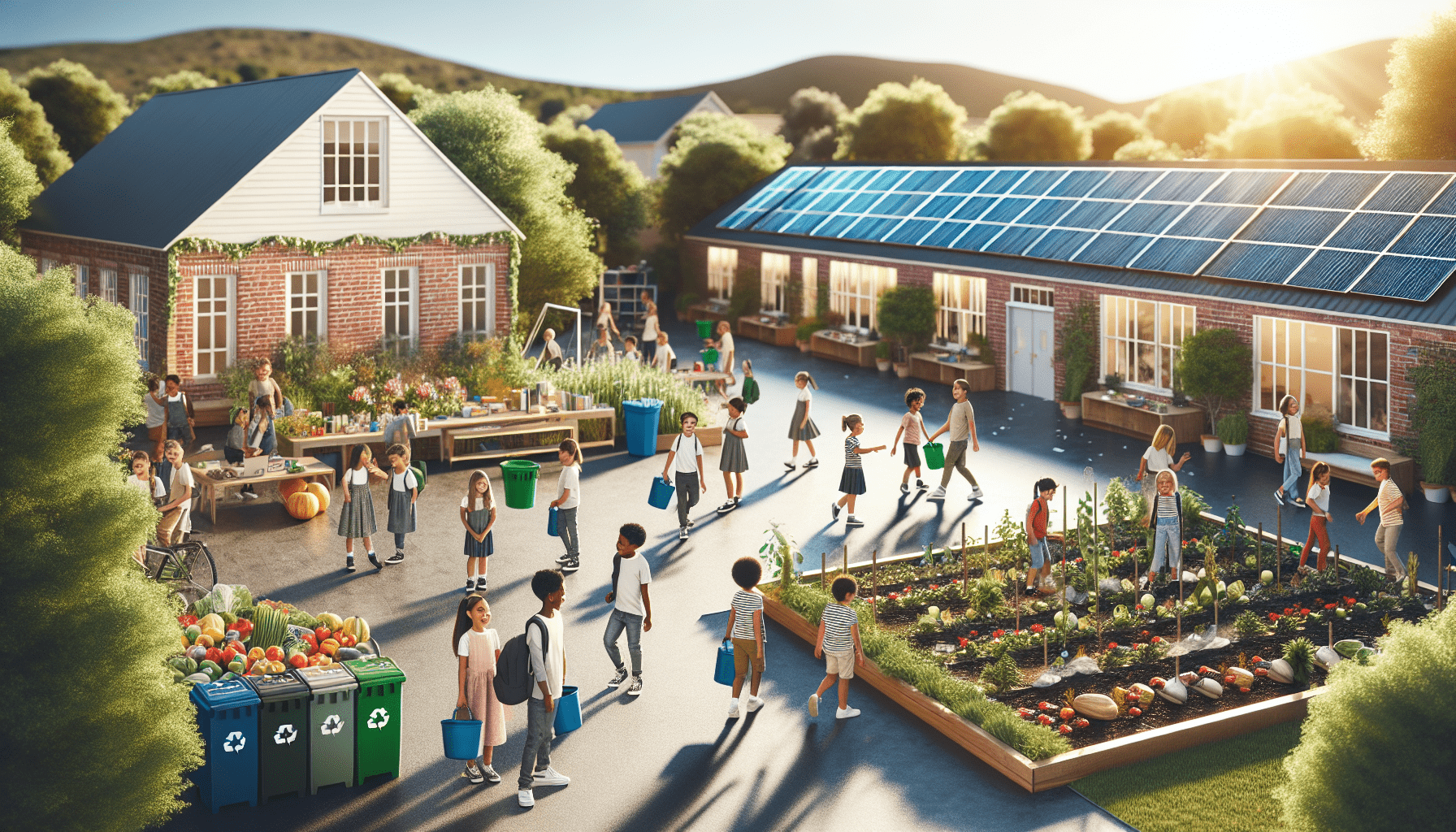In today’s world, it’s more important than ever for us to guide our educational institutions towards sustainability. How can schools promote sustainability? By integrating eco-friendly practices into daily routines, incorporating environmental education into the curriculum, and encouraging green initiatives among students and staff, we can make a significant difference. Whether it’s through starting a recycling program, creating a school garden, or hosting energy conservation challenges, we have numerous opportunities to foster a culture of sustainability within our schools, setting a strong example for future generations. How Can Schools Promote Sustainability?
Have you ever wondered how schools can play a vital role in promoting sustainability? We believe that educational institutions are extremely important in shaping future generations’ mindset and behaviors towards the environment. By integrating sustainable practices into the school culture, curriculum, and operations, we can cultivate a more eco-conscious society.
Introduction to Sustainability in Schools
Sustainability is not merely a buzzword; it’s a necessity for ensuring a healthy planet for future generations. Schools, as significant influencers of young minds, hold a critical position in encouraging sustainable practices. By incorporating sustainability into every aspect, from curriculum to campus management, educational institutions can instill a lasting eco-conscious mindset in students.
What is Sustainability?
Before diving into how schools can promote sustainability, let’s clarify what we mean by the term. Sustainability refers to the ability to maintain or improve social, economic, and environmental conditions for the long term. It’s about meeting our present needs without compromising the ability of future generations to meet theirs. In schools, this translates to adopting teaching strategies and operational practices that benefit both students and the planet.
The Importance of Sustainable Schools
Promoting sustainability in schools isn’t just about reducing the carbon footprint; it’s about fostering a culture of environmental stewardship among students. This section will discuss why it’s crucial for schools to embrace sustainable practices.
Educational Impact
When we embed sustainability into the curriculum, we are not merely imparting knowledge; we are shaping attitudes and behaviors. Students learn to think critically about environmental issues and develop problem-solving skills needed to address these challenges.
Environmental Impact
Schools typically have a high consumption of energy, water, and other resources. By adopting sustainable practices, schools can significantly reduce their environmental impact. This not only conserves resources but also sets an example for the community.
Economic Benefits
Though initial investments in sustainable infrastructure and practices may seem costly, they often lead to long-term savings. Energy-efficient buildings, waste reduction programs, and sustainable transportation options can considerably cut operational costs.

Creating a Sustainable Curriculum
One of the most impactful ways schools can promote sustainability is through the curriculum. By integrating sustainability topics into various subjects, we can offer students a comprehensive understanding of environmental issues.
Interdisciplinary Approach
Sustainability isn’t confined to science classes. We can incorporate it into subjects like mathematics (through data analysis of resource consumption), literature (by exploring environmental themes in texts), and social studies (by examining the socio-economic aspects of sustainability).
Involving Students in Projects
Projects that involve real-world environmental issues can be highly effective. Students could work on projects like energy audits for the school, waste management plans, or community gardens. These projects provide practical experience and foster a sense of responsibility towards the environment.
Environmental Literacy Programs
Introducing standalone programs focusing on environmental literacy can further strengthen students’ understanding. Workshops, guest lectures, and interactive sessions can provide more depth and context to sustainability topics.
Table: Ways to Integrate Sustainability into Curriculum
| Subject | Sustainability Integration Example |
|---|---|
| Science | Renewable energy sources, ecosystem dynamics |
| Mathematics | Statistical analysis of school’s electricity usage |
| Literature | Reading and analyzing books with environmental themes |
| Social Studies | Studying the impact of legislation on environmental policy |
| Art | Using recycled materials for projects |
Sustainable Campus Practices
Aside from curriculum changes, we can make substantial progress by adopting sustainable practices in the school’s daily operations. This includes energy efficiency, waste reduction, water conservation, and sustainable transportation.
Energy Efficiency
Switching to energy-efficient infrastructure is one of the most impactful changes schools can make. This includes using LED lighting, energy-efficient HVAC systems, and incorporating renewable energy sources like solar panels.
Waste Reduction
Effective waste management involves reducing, reusing, and recycling materials. Schools can set up recycling stations, eliminate single-use plastics, and promote digital note-taking to reduce paper waste.
Water Conservation
Implementing water-saving fixtures, fixing leaks promptly, and using native plants in landscaping can significantly reduce water usage. Schools can also educate students about the importance of water conservation through signage and initiatives.
Sustainable Transportation
Encouraging walking, cycling, carpooling, or the use of public transport can reduce the school’s overall carbon footprint. Schools can also provide bike racks and safer pathways to support these initiatives.
Table: Sustainable Campus Practices
| Practice | Description |
|---|---|
| Energy Efficiency | LED lighting, energy-efficient HVAC, solar panels |
| Waste Reduction | Recycling programs, no single-use plastics, digital note-taking |
| Water Conservation | Water-saving fixtures, fixing leaks, native plants |
| Sustainable Transport | Encouraging walking, cycling, carpooling, public transport |

Involving the School Community
Creating a culture of sustainability requires the engagement of the entire school community, including students, staff, parents, and local organizations. Collaboration and involvement are key to making the shift towards a more sustainable school.
Student-Led Initiatives
Encouraging students to take the lead in sustainability projects can result in innovative ideas and stronger buy-in. This could include forming eco-clubs, running awareness campaigns, or leading community clean-up drives.
Staff Training and Participation
It’s essential for staff to be equally committed to sustainability. Regular training and workshops can help teachers and administrators understand the value of sustainable practices and how to implement them.
Parental and Community Engagement
Involving parents and the local community can amplify the impact of school sustainability initiatives. This might involve hosting sustainability fairs, involving parents in school projects, or partnering with local environmental organizations.
Collaborative Events and Competitions
Hosting events like sustainability-themed fairs, competitions, or even green award ceremonies can bring the school community together, reinforcing the importance of sustainable practices.
Monitoring and Evaluation
It’s not enough to implement sustainable practices; we must also regularly monitor and evaluate their effectiveness. This helps in making necessary adjustments and improvements.
Setting Clear Goals
Having clear, measurable goals for sustainability initiatives is crucial. Whether it’s reducing energy consumption by a certain percentage or increasing recycling rates, specific targets provide focus and direction.
Regular Audits
Conducting regular energy, waste, and water audits helps in tracking progress. These audits can also highlight areas needing improvement, allowing for timely interventions.
Feedback Mechanisms
Encouraging feedback from students, staff, and parents can provide valuable insights into the success and reception of sustainability efforts. This feedback can be gathered through surveys or suggestion boxes.
Reporting Progress
Transparency is key to building trust and commitment. Regularly reporting progress to the school community ensures everyone stays informed and motivated. This can be through newsletters, school assemblies, or dedicated sustainability reports.

Building a Sustainable Culture
Creating a lasting impact requires establishing a culture of sustainability that permeates all aspects of school life. This involves consistent communication, modeling behavior, and celebrating successes.
Communication Strategies
Effective communication is essential for fostering a culture of sustainability. Using posters, announcements, and digital platforms to share tips, updates, and success stories can keep sustainability top of mind.
Leading by Example
School leaders, teachers, and staff need to model sustainable behavior. This includes simple actions like reducing waste, conserving energy, and supporting sustainability initiatives.
Celebrating Successes
Recognizing and celebrating milestones and achievements in sustainability keeps the momentum going. This can be through awards, certificates, or special assemblies acknowledging efforts and successes.
Challenges and Solutions
Promoting sustainability in schools isn’t without its challenges. We must identify these potential obstacles and develop strategies to overcome them.
Financial Constraints
One of the biggest challenges is often the initial financial investment required for sustainable infrastructure and practices. Seeking grants, government funding, and community donations can help mitigate these costs.
Resistance to Change
Change can be difficult, especially in established institutions. Providing education, training, and clear communication about the benefits of sustainability can help overcome resistance.
Maintenance and Upkeep
Sustainable practices often require ongoing maintenance and monitoring. Creating a dedicated sustainability team or committee can ensure these efforts remain a focus and are continuously managed.
Table: Challenges and Solutions in Promoting Sustainability
| Challenge | Solution |
|---|---|
| Financial Constraints | Seeking grants, government funding, community donations |
| Resistance to Change | Education, training, clear communication of benefits |
| Maintenance & Upkeep | Dedicated sustainability team, continuous management |

Conclusion: A Call to Action
Schools hold the power to shape the future by promoting sustainability. Through changes in curriculum, campus practices, community involvement, and building a sustainable culture, schools can make a significant impact. It’s a collective effort that requires the commitment of the entire school community. Together, we can foster a generation of environmentally conscious individuals ready to take on the challenges of tomorrow.
How will our school take the first step towards a more sustainable future? The journey begins now. Let’s come together and make it happen for the sake of our planet and future generations.




